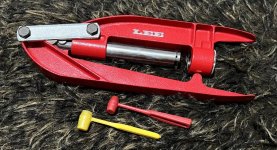Malysh
Member
Looking through Ammo Seek's 5 pages of 357 ammunition, I find no 158 grain loadings for LWSHP or SJHP. Lot's of SJ solid lead flat nose and fully jacketed hollow point.
In my casual research I am led to believe that 125 gr. loadings are not good for my Model of 1950 357 magnum and especially for my late 1970s 3" bbl. Mod. 13. I have also heard that fully jacketed projectiles are not good for revolvers, although I see a lot of offerings in 130 gr. fully jacketed 38 Special and 125 gr. 357. I have about 100 rds. of older Remington SJLHP ammo I could use in the rare event I might need it for self defense.
Ideally, I would like to find some ammo I described to use as target and self defense ammo in 158 grain.
It seems nobody is making lead hollow point or even SJHP, but tons of flat nose lead SJ.
Is the 158 gr. 357 LSWHP no long considered a good 357 magnum cartridge?
In my casual research I am led to believe that 125 gr. loadings are not good for my Model of 1950 357 magnum and especially for my late 1970s 3" bbl. Mod. 13. I have also heard that fully jacketed projectiles are not good for revolvers, although I see a lot of offerings in 130 gr. fully jacketed 38 Special and 125 gr. 357. I have about 100 rds. of older Remington SJLHP ammo I could use in the rare event I might need it for self defense.
Ideally, I would like to find some ammo I described to use as target and self defense ammo in 158 grain.
It seems nobody is making lead hollow point or even SJHP, but tons of flat nose lead SJ.
Is the 158 gr. 357 LSWHP no long considered a good 357 magnum cartridge?


